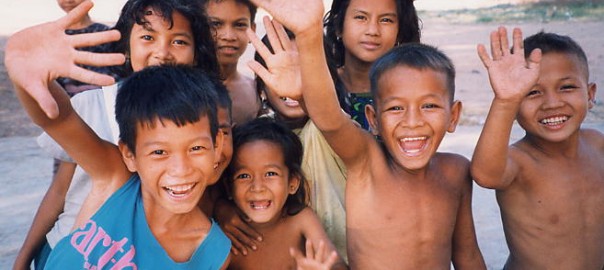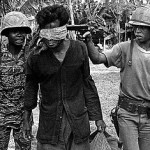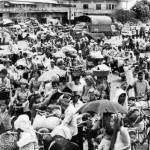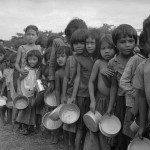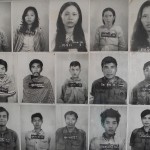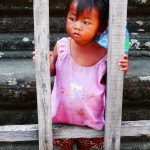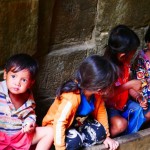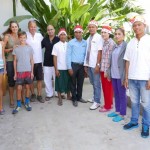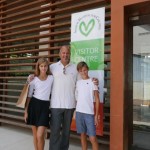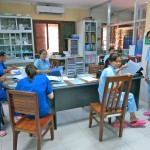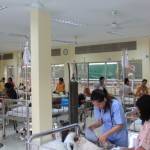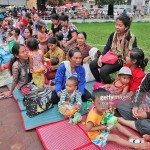The people of Cambodia are the nicest, most welcoming people I have ever met. They’re all smiles though a little shy sometimes. But the sad thing is, they have suffered a great deal. A horrific and tragic era of Cambodian history began in 1975 in the reign of the Khmer rouge. They were led by Pol Pot. A few days after the Khmer Rouge took power, they forced about 2 million people in Cambodia’s capital city Phnom Penh and other cities into the countryside to undertake agricultural work. This was done at gunpoint. Thousands of them died during these evacuations.
Les Cambodgiens sont tellement gentils, toujours souriants et aimables. Mais c’est un peuple qui a énormément souffert. En 1975 Pol Pot arriva au pouvoir et alors commença pour eux des décennies d’horreur avec les Khmers Rouges. Ils ont exilé de force avec les armes 2 millions de personnes des différentes villes du pays vers les campagnes, ils voulaient créer la même philosophie que la Chine avec Mao. Des milliers de personnes moururent.
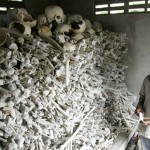
The Khmer Rouge wanted to transform Cambodia into a rural, classless society in which there were no rich people, no poor people, and no exploitation. To accomplish this, they abolished money, free markets, all schooling, private property, foreign clothing styles, religious practices, and traditional Khmer culture. Public school, pagodas, mosques, churches, universities, shops, and government buildings were shut down or turned into prisons, stables, and reeducation camps. During this time, everyone was deprived from their basic rights, they couldn’t leave their cooperative or even have an unsupervised discussion. The Khmer Rouge claimed that only “pure” people can build up a revolution. They killed thousands of soldiers, and military officers whom they did not find “pure” because they followed Marshal Lon Nol, someone the Khmer Rouge opposed. They also executed hundreds of thousands of intellectuals, doctors, city residents; and minority people like Vietnamese, Chinese, and many of their own party members who were accused of being traitors. Most of these people were held in prisons, where they were detained, interrogated, tortured, and executed.
Les Khmers Rouges voulaient transformer le pays en société rurale sans classe sociale sans riches ni pauvres. Ils ont aboli l’argent, le commerce, les écoles, plus le droit d’être propriétaire de biens (maison, voiture), interdiction de porter des vêtements occidentaux, plus de religion, de magasins. Le nouveau gouvernement récupéra tous les bâtiments pour en faire des prisons des camps de réeducation ou des étables.Durant cette période, les gens n’avaient plus le droit de rien, pas parler en public avec d’autres personnes, ils ne pouvaient plus rien posséder. Les Khmers Rouges voulaient que leur Revolution soit faite uniquement par des personnes pures et par example tous les officiers et les policiers furent exécutés car ils suivaient les ordres du General Marshal Lon Nol un opposant à leur cause. Ils exécutèrent tous les intellectuels (docteurs, professeurs etc) mais aussi les minorités (Vietnamiens, Chinois) et même certains de leur propre parti qu’ils considéraient comme des traitres s’ils n’étaient pas d’accord avec les ordres. La plupart de ses prisonniers étaient torturés avant d’être exécutés.
The most important prison S-21 held about 14,000 prisoners while in operation. Only about 12 survived. On top of all this, the Cambodians were expected to produce three tons of rice per hectare (10,000mi squared) throughout the country. This meant that people had to grow and harvest rice all 12 months of the year. In most regions, the Kmer Rouge forced the people to work 18 hours a day with only I small tin of rice every 2 days and no breaks. In 1999, when the Khmer Rouge was defeated and Pol Pot was dead, 2 million Cambodians had died of disease due to the malnutrition, lack of medicine and medical services. But now, Cambodia has a new government and its economy is growing rapidly due to tourism and the exportation of textiles, though they still are a poorer nation. Even with everything that they’ve been through, the Cambodian people have remained optimistic about their future and are still wonderful people.
La prison la plus connue S-21 accueilla pas loin de 14 000 prisonniers, 12 survivant seulement. Les gens dans les campagnes devaient produire 3000kg de riz par hectare, ils étaient obligés de travailler tous les jours de l’année pendant 18 heures et ils avaient droit à seulement un bol de riztous les 2 jours. Beaucoup de gens succombaient de malnutrition ou de maladies. En 1999 Pol Pot fût jugé, il tua plus de 2 million de Cambodgiens. Maintenant, même si la corruption existe encore dans certains domaines, l’économie du pays est en pleine croissance surtout grâce au tourisme et à l’exportation de textiles. C’est encore un pays en voie de développement, ils sont entrain de repeupler leur pays très vite, il y a des enfants de partout. Par rapport à leur histoire, je les ai trouvé chaleureux, on dirait qu’ils ont tiré un trait sur le passé et que maintenant seulement le futur est important.
The staff of the 2 hotels we stayed in were just amazing, especially the Green Leaf, Tak and Lin were always making sure Jayden and I had everything we needed. On Christmas day, we did not exchanged gifts but instead we visited the children’s hospital, what an eye opening it was, when Pol Pot left there were 40 doctors remaining in this country. So you can imagine if you got sick or injured yourself the outcome would not be great, but now they are forming new doctors and slowly thy are filling those gaps. The children hospital is the only one around this region and people sometimes travel from very far to come here. They may have to sell a cow or their house to pay for the transport. But here at the hospital they provide good care and its free, they also provide food and a hamac for the family because they know they don’t have money to pay for a hotel. They form nurses and doctors and dentists there as well as providing care. The waiting room was full when we were their. They need a new roof for a section of the buildings and they were raising money for it, we felt strongly about it and donated. They really want to be able to open another smaller unit in the country side so the people will not have to travel as far and maybe some lives can be saved. It was a very humbling experience, because for us we know where to go if we need care. It is not always the case for everybody.
Le personnel des 2 hôtels où nous avons séjournés ont été vraiment formidables, encore plus le Green Leaf. Tak and Lin étaient aux petits soins pour mon frère et moi. Le jour de Noël nous n’avons pas eu de cadeaux mais à la place nous avons visité l’hôpital pour enfants de Siem Reap et fait une donation. J’ai vraiment appris beaucoup de choses, quand Pol Pot est arrivé au pouvoir il y avait 4000 docteurs dans le pays quand il en est parti il ne restait que 40 docteurs. Il n’est pas difficile d’imaginer que si tu étais malade tu n’avais pas beaucoup de chance d’échapper à la mort. Mais grâce à un Japonais un hôpital pour enfants a pu ouvrir et maintenant les gens viennent de tout le pays pour s’y faire soigner. Parfois les gens des campagnes doivent vendre leur maison ou une vache pour payer pour le transport pour arriver jusqu’à l’hôpital. Ils essayent d’ouvrir une autre branche dans le pays, cela permettrait de sauver plus d’enfants qui parfois auraient besoin d’être soigner immédiatement. Ils forment des docteurs ici, ainsi que des chirurgiens et des dentistes. Ils permettent aux gens de dormir dehors sous des abris et de faire leur propre cuisine quand ils ont quelqu’un hospitalisé. Les soins sont gratuits. Le jour de notre visite la salle d’attente était pleine et c’est tous les jours comme ça. Je ne me rendais pas compte que certaines personnes n’avaient pas accès aux soins, car pour nous ça n’a jamais été un problème. Nous n’avions pas le droit de prendre des photos par respect pour les personnes donc je ne pourrais pas l’illustrer mais ça reste un moment fort pour moi.
